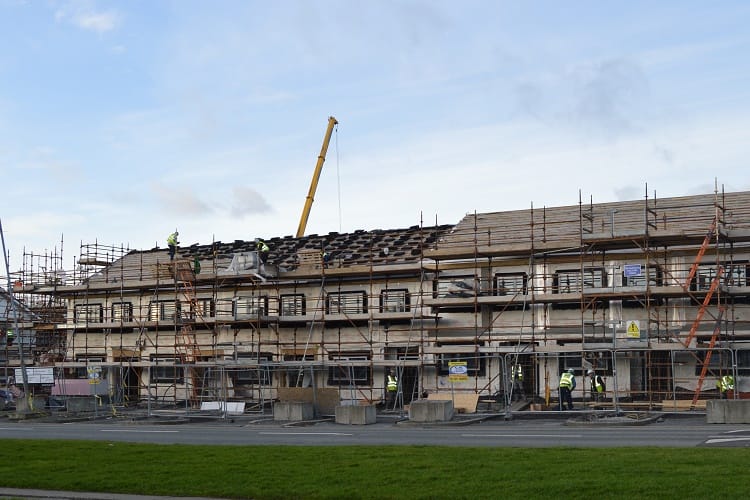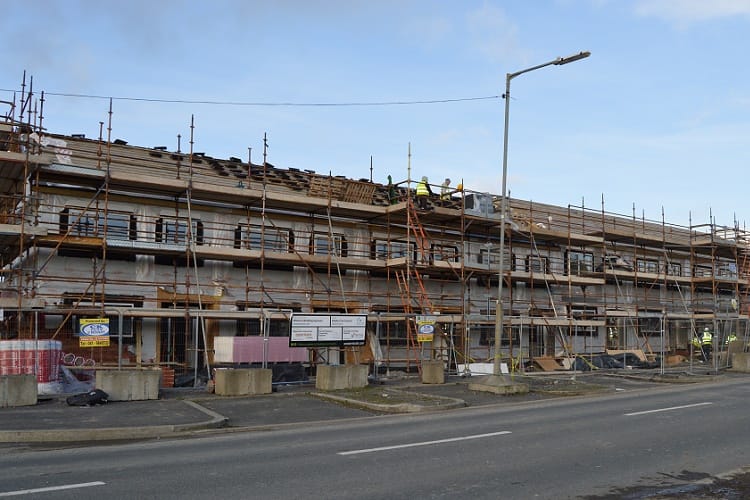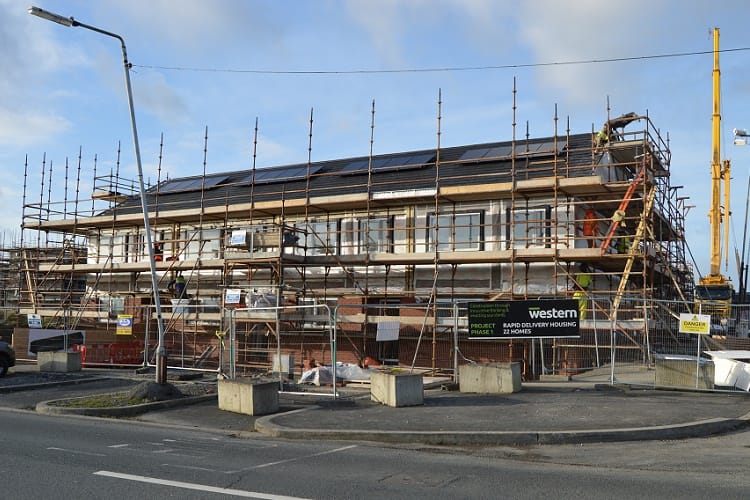What’s the best way to tell area residents about plans for a new asylum shelter nearby?
The government should tell communities directly about plans for new asylum shelters, some activists and politicians say.
People working in the industry say that it was always an impossible mission to get the homes ready before Christmas.

The 22 units of “modular housing” being built on a site off Balbutcher Lane in Poppintree are still under construction more than a month after they were due to be completed.
And we don’t know exactly when they’ll be done. Dublin City Council won’t given a new end-date for the €4.2 million project. A spokesman for the Department of the Environment, John Whelan, says they should be done by the end of this month.
Originally, the homes were set to be finished by 21 December, so that homeless families from the area could move in before Christmas. This date was one of the main criteria set by Dublin City Council during the procurement process.
The council have blamed delays on bad weather, two days’ disruption caused by protests and unconfirmed reports of threats made by thugs in balaclavas. (We filed a freedom-of-information request for records about the supposed incident with the thugs in balaclavas, but didn’t get anything enlightening.)

But now, 44 days after the original deadline, it’s time — or even past time — to ask if the modular homes could have ever been completed in such a short amount of time, even without any disruptions.
Vivian Cummins, an architect based in Kildare with extensive knowledge on housing, planning and building regulatory matters, says he knew the units would never be ready before Christmas.
Not to knock the efforts, he says, but it couldn’t have been done. “And I don’t think anybody who knows anything about building thought that,” he said.
Without even taking into account how swiftly the houses could have been erected, he says, they could never have been done on time because of the complex building control regulations.
Though the council managed to fast-track the process by skipping the Part VIII planning application — and therefore public consultation — other statutory legislation couldn’t be avoided, he said.
The tender documents set out that the houses would have to be designed and constructed in accordance with all statutory building regulations. Monitoring and enforcement of these regulations would also have to be carried out.
These regulations include serving a commencement notice to the Building Control Management System, which must be done 14 to 28 days before starting work on site, as well as a completion certificate three to five weeks before completion.
In a detailed article on BRegs Blog, Cummins estimated that to get the go-ahead for the homes to be occupied before Christmas, completion documents would have to have been submitted in November. That’s before work started.
Besides, “You can’t blame weather for a delay in a contract in December,” he laughs. “You know the weather can’t be relied on.”

Cummins is far from a lone voice. Many other industry experts agree.
Three of the six companies who displayed their wares at Dublin City Council’s modular housing exhibition last September said that it was an impossible mission.
With little notice, MOM Services Limited spent about €200,000 erecting sample homes for the exhibition, said managing director John Boyle. And though the company put in a tender to build the first 22 units, it stated clearly on it that the houses couldn’t be completed by 21 December, he said.
Barry Alder of Modular Housing Ireland, which spent €100,000 on the exhibition, also said the units couldn’t be done on time and didn’t get the tender either. “It was never possible, because they didn’t give us enough lead time into it,” he says.
Spacebox put in an initial expression of interest, but after reading the tender documents didn’t follow up with a bid.
“The documents we saw were very, very light on detail and we did not feel that it was a serious tender proposition,” says the company’s managing director, John Fitzgerald.
As Alder sees it, the whole modular housing exhibition and push to get the houses in place before Christmas was a politically motivated PR stunt in the run up to the general election.
This is another point of agreement between him and Cummins. “This thing is costing a fortune. These houses are now €200,000 a piece,” he says. “It was a ludicrous PR stunt and there’s a real question over who’s now paying for the delay.”
(We asked Dublin City Council if the local authority or Western Building Systems would be covering the cost, but it did not respond.)
The minister would have been better off driving around Poppintree and buying every house for sale, says Cummins. “They would have gotten houses for half the price and they would have had everyone moved in straight away.”
He’s not far off. A three-bedroom terraced house nearby is currently on the market for €150,000.
So why did the council not do this? The council does regularly buy houses on the market, according to a spokeswoman. But it wanted a site with houses grouped together to accommodate constantly changing tenants and wrap-around services for homeless families, she said.
At least they’re adding to supply.

Permanent Housing?
In yesterday’s Irish Times, Minister for the Environment Alan Kelly and TD John Lyons of Labour were pictured sitting in a fully-furnished modular home on the Poppintree site.
Was this another PR set up? Today at the site, the houses were far from finished.
In the article, Kelly said the modular houses are indistinguishable from normal houses and could become permanent homes.
Perhaps this is because they are your standard, traditionally built, permanent houses.
“What’s under construction out there at Poppintree, I don’t think anyone would actually call that modular housing,” says Cummins.
Though there isn’t a strict legal definition of the term modular housing, it is generally understood to mean houses built in a factory and then assembled on site.
“You know everything would be completely finished – the bathrooms, the kitchen, the tiles,” he explains. “And literally they are then brought out on lorries and cranes slot them into position.”
The 22 units under construction wouldn’t be considered modular housing by most people in the industry, he says. It’s traditional timber-frame construction, which is faster than using concrete blocks.
They’ve put in foundations, constructed timber walls, and put cladding on the outside, says Cummins, all on site.
Photos of earlier stages of construction clearly show the timber frames.
Yesterday afternoon, the site was buzzing with activity.
Scaffolding surrounded each set of four houses. Some men were drilling, some sawing wood. Some were tiling roofs. A heavy-duty forklift left a hefty pallet of tiles for them. Piles of red bricks sat on the mucky ground, the leftovers from the process of laying bricks to form house facades.
It’s safe to say there was plenty of construction taking place on site, much more, arguably, than just assembling components from a factory. And it raises the question of whether these houses are here to stay. It’s hard to see how they can be put on the back of a truck for transportation elsewhere.
“Nobody in the industry thinks that’s modular housing,” says Cummins.
Both Boyle of MOM and Fitzgerald of Spacebox confirm that the tender documents used the term modular housing, but the criteria listed simply called for fast-tracked housing.
“We are very focused, we are in modular housing and the proposal they came up with was for just regular housing,” says Fitzgerald.
This would explain the higher-than-expected costs and longer construction time of the houses. Buildings constructed on site usually take more time, pushing costs up.
Pat Kilkenny of Nordman Profile Ltd, a manufacturer for modular housing companies, says the 22 houses were unlikely to have been finished on time, particularly because they are conventional timber-framed houses, rather than the modular houses expected.
The general public and commentators are under the impression that the 22 houses in Poppintree are modular, Kilkenny says, he is worried that this will create a negative view of the industry.
At the modular housing exhibition, the costs of most houses were in and around €100,000 rather than €200,000.
“The modular homes exhibition correctly promoted high-quality economical homes which can be delivered in rapid time,” he says of the council’s event last September.
The contractor constructing the 22 units, Western Building Systems, did not respond to any questions.
But Whelan of the Department of Environment says it is modular housing that is being built on the Poppintree site.